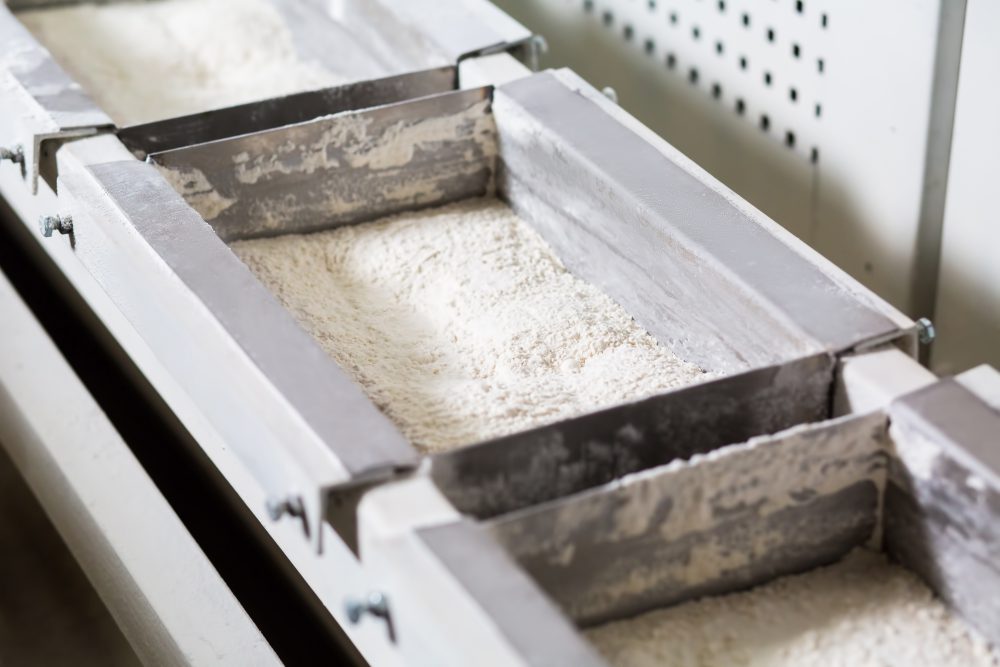Controlling dust is a major concern in food manufacturing, whether you’re roasting coffee beans, mixing spices or using flour as a release agent for your baked goods. Whenever there is potential dust in your processing environment, you want to capture it at the source.
Managing dust is critical for a variety of reasons:
- Breathability — Excess dust in the atmosphere can make it difficult for plant personnel to breathe.
- Explosions — Very fine explosive dust has a high surface-to-volume ratio, which can make it extremely combustible at a high concentration. The right conditions mixed with an ignition source could trigger an explosion in your facility. Lab tests can determine the category of explosiveness for a particular dust, which dictates the level of protection required.
- Food safety — Dust can settle on and contaminate products before they are packaged. This is especially an issue when it comes to allergens, such as avoiding cross-contamination of flour on gluten-free products.
Dust collection systems serve as specialized “vacuum cleaners” to keep dust from overflowing into other areas. But how do you know which one is right for your specific process?
Industrial point-of-use vs. central dust collectors
There are two common systems that vary in the way that dust is collected. The right choice depends on the environment and nature of your processing.
Point-of-use dust collectors
A point-of-use, or unit, dust collector is a self-contained system that is placed at the source of dust creation. They are suitable for isolated, portable or frequently moved dust-producing operations.
- Pros: In general these are safer, cheaper and easier to maintain than central systems. They also can remain below 10 cubic feet of volume, excluding them from National Fire Protection Association (NFPA) code requirements.
- Cons: They take up more total floor space than a central system, since you typically need multiple units throughout your processing area. Point-of-use collectors can be less efficient depending on the size of your space and volume of dust being created. Plus, the collected dust must be manually emptied frequently and the filters cleaned regularly.
Central dust collectors
Central dust collection systems are ideal for larger-scale operations in which a high volume of dust is created.
- Pros: These collectors can capture dust from multiple locations with one vacuum source. They take up less floor space than multiple point-of-use units, and since there are fewer moving parts, maintenance is required less frequently.
- Cons: Central systems are generally more expensive so they require a greater initial investment. Since they are larger and typically have collection areas greater than 10 cubic feet of volume, these systems require explosion venting, explosion suppression or other safety features to meet NFPA regulations. They also require permanent ducting with possible roof penetrations to exhaust the air, as well as permanent electrical and compressed air supplies.
Dust collector filters: Bags vs. cartridges
Whether you choose a point-of-use or central dust collection system, there are two common types of filters that can be used.
- Bag filters — These filters generally require more maintenance because they must be washed and reinstalled properly. Depending on the air velocity and pulse frequency of your system, these cloth bags typically last about a year before they need to be replaced.
- Cartridge filters — These filters don’t need to be serviced as often and can use reverse airflow to clean itself to a degree. The materials used in a cartridge filter are also more rigid, making them less susceptible to wear and tear compared to bag filters. Cartridge filters generally last up to five years. However, the pleats in cartridge filters are more susceptible to blinding on certain materials being collected. When that occurs, they are very difficult to clean and must sometimes be replaced.
Note: Some dusts are abrasive and may require special inlet materials and filter materials.
Recycling clean dust
In some cases, dust can be reused for other applications. We recently installed a central dust collection system at a doughnut plant that reclaims collected flour and sprinkles it onto the dough to minimize ingredient application. Of course, this can only be done with clean dust, typically with one type of product at a time, and with ensured quality control.
Both point-of-use and central dust collectors can be used to reclaim flour, but of course it’s not a necessity. Many facilities simply dispose of the dust, especially if it’s been contaminated.
Need more help determining the best dust collection strategy for your facility? Our experts are happy to help! Comment below or send me your questions at foodforthought@stellar.net



